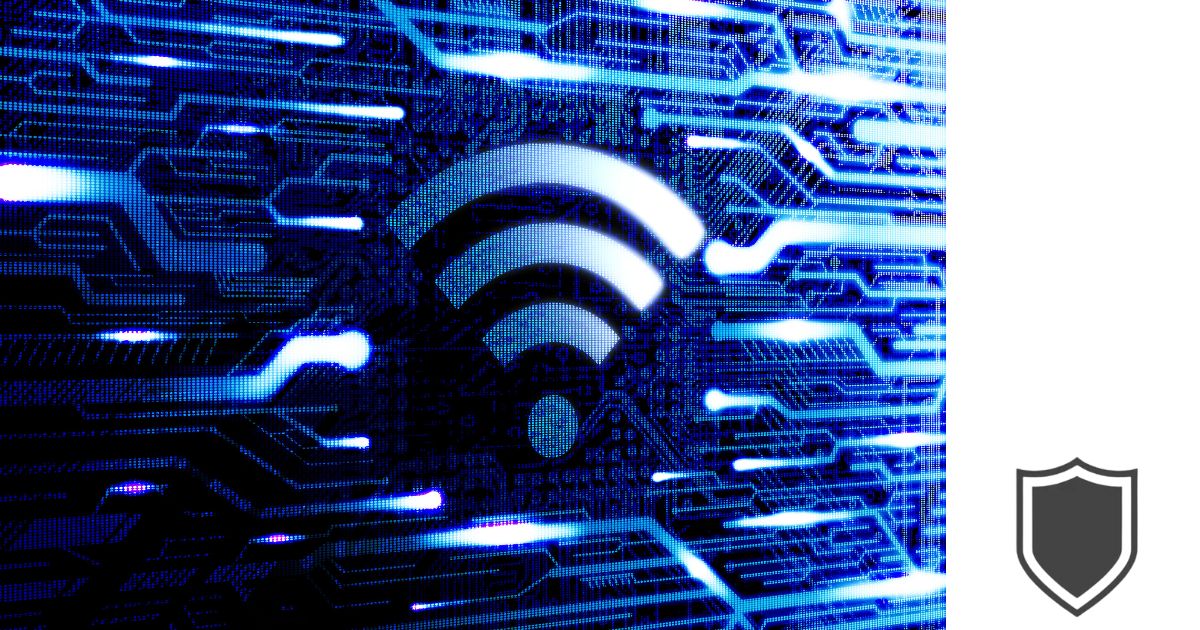Imagine exploring the endless waves of the wireless realm, a territory freed from the limitations of wires and cables.
It’s a world that offers us immense convenience, allowing us to connect, communicate, and browse from almost anywhere.
Yet, just like any frontier, it has its hazards. Hidden in the unseen corners of these digital airwaves are potential threats, ready to intercept and exploit unsecured connections.
So, how do we safeguard our wireless journeys? Enter wireless encryption, our silent protector in the wireless world.
In this article, we’re taking a deep dive into types of wireless encryption, where we’ll unravel the intricacies of these invisible guards, equipping you with the knowledge to safely navigate the wireless landscape.
Strap in and get ready for a journey into the unseen layers of wireless security.
Table of Contents
Wireless Encryption Fundamentals
As you start learning about wireless encryption, it’s important to understand that encryption is a crucial aspect of securing your Wi-Fi networks. Wireless encryption provides a layer of security by scrambling the data transmitted over your Wi-Fi network and making it unreadable to unauthorized users. This helps protect both your personal information and your connected devices from malicious intrusions.
There are several types of encryption protocols used in wireless security. These include Wired Equivalent Privacy (WEP), Wi-Fi Protected Access (WPA), WPA2, and WPA3. Each of these protocols offers different levels of security and encryption, with WEP being the least secure and WPA3 being the most secure. When setting up your Wi-Fi network, it’s vital to choose an encryption type that provides strong protection against unauthorized access.
WEP was the first encryption protocol introduced for wireless networks, but it is now considered outdated and insecure. It uses a relatively weak encryption algorithm, making it easy for hackers to crack and gain unauthorized access to your network. You should avoid using WEP to protect your Wi-Fi network.
WPA came after WEP as an improvement, offering better encryption and security features. It uses a stronger encryption method called Temporal Key Integrity Protocol (TKIP), which is more difficult to crack than WEP. However, WPA still has some vulnerabilities and is not considered the best option for securing modern Wi-Fi networks.
WPA2 is an upgraded version of WPA that provides enhanced security by using the Advanced Encryption Standard (AES) algorithm. AES is more secure and robust than TKIP, making WPA2 a better option for Wi-Fi encryption. It also includes additional features like Protected Access Management Frames (PMFs) to further increase network security. WPA2 is widely recommended for wireless network security.
WPA3 is the latest encryption standard, introduced in 2018. It offers even better security features compared to WPA2, including simplified Wi-Fi security, stronger authentication, and increased cryptographic strength. The mandatory use of PMFs in WPA3 networks makes it harder for hackers to conduct eavesdropping and other types of attacks. Adopting WPA3 is a smart choice if your devices support it.
Here’s a table to help you visualize the different types of wireless encryption:
| Wireless Encryption Protocol | Introduction Year | Key Features | Security Level |
|---|---|---|---|
| WEP | 1997 | First encryption protocol for wireless networks; Uses relatively weak encryption algorithm | Low; Considered outdated and insecure |
| WPA | 2003 | Uses Temporal Key Integrity Protocol (TKIP); Offers better encryption and security features than WEP | Medium; Has some vulnerabilities but more secure than WEP |
| WPA2 | 2004 | Uses Advanced Encryption Standard (AES); Includes features like Protected Access Management Frames (PMFs) | High; Considered secure and widely recommended |
| WPA3 | 2018 | Offers simplified Wi-Fi security, stronger authentication, and increased cryptographic strength; Mandatory use of PMFs | Very High; Latest encryption standard with advanced security features |
Keeping your Wi-Fi network secure is vital to protect your personal information and prevent unauthorized access to connected devices.
Choosing the right encryption protocol and maintaining a strong password for your Wi-Fi network are critical steps in ensuring your wireless security.

WEP: Wired Equivalent Privacy
WEP Protocol
Wired Equivalent Privacy (WEP) was introduced in 1997 as the first security standard for wireless networks. Its goal was to provide a level of security and privacy for 802.11 wireless networks comparable to that of traditional wired networks. WEP uses the RC4 encryption algorithm for its default encryption key. This encryption algorithm is designed to help protect your data and prevent unauthorized access to your network.
To use WEP on your wireless network, follow these steps:
- Access your router’s configuration settings.
- Select “Wireless Security” or a similar option.
- Choose “WEP” as the security mode.
- Configure the WEP encryption key settings according to your router’s instructions.
- Save the settings and restart your router if needed.
WEP Vulnerabilities
Despite its initial purpose, WEP has a number of security flaws that make it vulnerable to attacks. WEP’s RC4 encryption algorithm has well-known weaknesses, including a relatively short key length and a static, unchanging key. These vulnerabilities allow attackers to easily crack the encryption and gain unauthorized access to your network.
Here are some of the security flaws you should be aware of with WEP:
- Limited key length: WEP uses either 40-bit or 104-bit encryption keys, which are relatively short compared to modern standards. This makes it easier for attackers to guess or brute-force the key.
- Static keys: WEP uses the same encryption key for all data transmitted on the network, making it easier for attackers to collect enough data for a successful attack.
- Weakness in the RC4 algorithm: The RC4 algorithm used in WEP has known weaknesses that can be exploited by attackers, further compromising the security of your network.
Due to these vulnerabilities, experts advise against using WEP for your wireless network security. Instead, consider using a more advanced security standard, such as WPA or WPA2, to better protect your network and data from potential threats.
WPA: Wi-Fi Protected Access
Wi-Fi Protected Access (WPA) is a wireless security protocol designed to address the weaknesses of Wired Equivalent Privacy (WEP) standards. It is an improvement over WEP, providing enhanced authentication and encryption features.
TKIP: Temporal Key Integrity Protocol
WPA uses the Temporal Key Integrity Protocol (TKIP) for encryption. TKIP provides data protection by generating a new encryption key for each data packet transmitted over the network. This dynamic key management makes it more difficult for attackers to decrypt network traffic compared to WEP’s static keys. However, TKIP is considered less secure than Advanced Encryption Standard (AES), which is used in its successor, WPA2.
PSK / EAP: Authentication Options
WPA offers two authentication options: Pre-Shared Key (PSK) and Extensible Authentication Protocol (EAP). WPA-PSK, also known as WPA-Personal, is typically used in home networks and small businesses. In this method, all devices on the network use the same passphrase to authenticate and gain access.
On the other hand, WPA-EAP, also known as WPA-Enterprise, is used in larger organizations. It requires an authentication server, such as a RADIUS server, to manage user credentials and authentication. This method provides individualized authentication, allowing administrators to grant or revoke access for specific users.
WPA Security Weaknesses
While WPA is a significant improvement over WEP, it still has some security weaknesses. One of the main vulnerabilities is its susceptibility to offline dictionary attacks, in which an attacker can capture the encrypted handshake between a client device and an access point (AP) and then attempt to crack the passphrase offline. To mitigate this risk, it is essential to use a strong, unique passphrase for your SSID.
Another weakness depends on the implementation and configuration of APs and clients. If an AP allows clients to negotiate using TKIP, an attacker could potentially downgrade the encryption to a weaker level, making it easier to break.
So, WPA is an important advancement in Wi-Fi security compared to WEP, but its weaknesses necessitate the adoption of stronger security protocols, such as WPA2 or WPA3, where possible. Ensure your network is properly configured and use strong passphrases to help protect your data from potential attacks.
WPA2: Wi-Fi Protected Access II
CCMP: Advanced Encryption
WPA2, or Wi-Fi Protected Access II, offers a more secure encryption method compared to its predecessor, WPA. One key improvement is the utilization of CCMP (Counter Mode Cipher Block Chaining Message Authentication Code Protocol). CCMP employs the Advanced Encryption Standard (AES) algorithm, which provides robust security for your internet connection on both Windows and macOS devices.
AES is a symmetric encryption algorithm that ensures the integrity of your data while in transit. This means that with a WPA2-enabled network, you can trust that your information remains confidential and protected from unauthorized access.
WPA2 Personal and Enterprise
WPA2 offers both Personal and Enterprise variants suitable for different needs. WPA2-Personal, also known as WPA2-PSK (Pre-Shared Key), is designed for home users and small businesses. In this mode, you create a passphrase that secures your Wi-Fi network – all devices connected to the network use the same passphrase. When choosing a passphrase, make sure it is unique and hard to guess to maximize your network’s safety.
On the other hand, WPA2-Enterprise is suitable for larger organizations that require more advanced security features. This mode uses a RADIUS server to authenticate users individually with unique credentials. As a result, it provides better control over who gains access to the network and simplifies the process of managing users.
WPA2 with CCMP offers enhanced security features compared to WEP or WPA, making it an effective choice for securing your Wi-Fi network. By understanding the differences between WPA2-Personal and WPA2-Enterprise, you can choose the most appropriate mode for your specific needs.
WPA3: Enhanced Wi-Fi Security
WPA3 Personal and Enterprise
The Wi-Fi Alliance introduced WPA3 as an upgrade to the widely used WPA2 security protocol. WPA3 comes in two primary forms to better suit different user needs: WPA3-Personal and WPA3-Enterprise. WPA3-Personal is designed for home users, offering improved password-based authentication and higher levels of protection. WPA3-Enterprise, on the other hand, targets businesses and organizations, providing even stronger encryption and security features to protect sensitive data.
OWE: Wi-Fi Enhanced Open
In addition to WPA3, the Wi-Fi Alliance introduced Opportunistic Wireless Encryption (OWE), also known as Wi-Fi Enhanced Open. OWE aims to improve security for open Wi-Fi networks, such as those in public spaces like coffee shops and airports. This protocol automatically encrypts data transmissions without requiring user passwords, providing a baseline level of security for public Wi-Fi users.
WPA3 Advantages
Among the key advantages of WPA3 over previous security protocols are:
- Increased cryptographic strength: WPA3 uses stronger encryption algorithms, making it more difficult for attackers to crack your Wi-Fi network.
- Simplified Wi-Fi security: WPA3 includes features that make it easier for users to configure their networks securely, reducing the chances of human error.
- Protected Management Frames (PMFs): WPA3 mandates the use of PMFs, enhancing overall network security by preventing malicious interference with network management traffic.
To better protect your Wi-Fi network and maintain a high level of security, it is recommended that you upgrade your devices and routers to support WPA3 whenever possible. This will help ensure that both your personal and enterprise networks are secure against potential attacks.

Additional Security Features
Apart from the common Wi-Fi encryption standards like WEP, WPA, and WPA2, there are additional security features that can enhance the protection of your wireless network. In this section, we will discuss three of these features: Wi-Fi Protected Setup (WPS), Network Access Control using SSID, and MAC Address Filtering.
WPS: Wi-Fi Protected Setup
Wi-Fi Protected Setup (WPS) is a feature that simplifies the process of connecting devices to your wireless network. With WPS, you can easily connect your devices without needing to enter a password. Instead, you can use a hardware button on your wireless access point or a PIN, reducing the risks associated with weak passwords.
However, WPS is not without its flaws. It has been found to be vulnerable to attacks, such as brute force methods to crack the PIN. As a result, it is crucial to understand the potential risks of using WPS and consider disabling it if you prioritize high security for your network.
SSID: Network Access Control
The network Service Set Identifier (SSID) is the name assigned to your Wi-Fi router or access point (AP). Controlling access to your wireless network using SSID is another layer of security you can implement. You can configure your APs to hide the SSID, effectively limiting access to your network only to those who know it.
When hiding your SSID, you should also set up strong security policies and utilize secure encryption methods, such as WPA2 or WPA3. This will ensure that even if someone knows your hidden SSID, they will still need a strong password to access the network.
MAC Address Filtering
Your device’s Media Access Control (MAC) address is a unique identifier that allows it to connect to networks. By implementing MAC address filtering on your Wi-Fi router, you can create a whitelist of allowed devices and restrict network access only to those devices with whitelisted MAC addresses.
While this method adds another layer of security, it is not foolproof. Skilled attackers can spoof a whitelisted MAC address and gain access to your network. Therefore, it’s important to combine MAC address filtering with other security features, such as robust encryption and strong passwords, to maximize the protection of your wireless network.
Implementation and Best Practices
When setting up your wireless network, it’s crucial to select the appropriate encryption method to ensure the security of your data. To maximize privacy and protect your network from breaches, follow these best practices for implementing wireless encryption.
First, access your router’s configuration interface to select the best encryption method. WPA3 is the latest and most secure option. If your router and devices are compatible, always choose WPA3 over older standards like WEP or WPA. If your router does not support WPA3, go for the WPA2 protocol, which is still a robust choice for securing your wireless network.
Next, create a strong, unique password for your network. A powerful password should be a combination of upper and lower case letters, numbers, and special characters. Avoid using easily guessable information like your birthdate or name. Regularly update your password to minimize the risk of unauthorized access.
To enhance network security, disable remote management of your router from the internet. This feature can be exploited by cybercriminals to gain unauthorized access to your router and compromise your network. Check your router’s user manual to know how to perform this action.
Consider creating a separate network for your IoT devices. IoT devices can be vulnerable to attacks, and segregating them from your primary network can prevent intruders from accessing sensitive data on your other devices. Enable guest networks for visitors to prevent them from accessing your main network.
When connecting to public networks, use a virtual private network (VPN) to encrypt your data and protect your privacy. VPNs cloak your internet activity and safeguard your information from potential cyber threats. Be cautious when accessing public Wi-Fi, as these networks can be a breeding ground for hackers.
Always monitor the firmware updates for your routers and wireless devices. Manufacturers often release security patches to fix vulnerabilities, so regularly updating your firmware can prevent potential attacks. By following these best practices, you can significantly improve your wireless network’s security level and protect your data from breaches.
Types of Wireless Encryption FAQs
What are the key differences between WEP, WPA, and WPA2?
WEP (Wired Equivalent Privacy) is the oldest wireless encryption protocol and provides minimal security. It has been deprecated due to its numerous vulnerabilities. WPA (Wi-Fi Protected Access) improved upon WEP by using TKIP (Temporal Key Integrity Protocol) for encryption, providing stronger security. However, WPA2 (Wi-Fi Protected Access 2) is currently the most widely used protocol, as it offers a more secure encryption method with AES (Advanced Encryption Standard).
How does WPA3 improve upon previous encryption methods?
WPA3, the latest encryption standard, offers enhanced security and privacy features compared to its predecessors. It implements stronger authentication methods, better protection against brute force attacks, and improved support for modern cryptography.
Which encryption methods are supported by the IEEE 802.11i-2004 standard?
The IEEE 802.11i-2004 standard supports WPA2 and AES encryption. It is the recommended security protocol for most Wi-Fi networks, providing a robust level of encryption and authentication to protect your digital data.
How can I determine the security type used by my Wi-Fi network?
To determine the security type of your Wi-Fi network, you can typically check the settings on your wireless router, as it will display the security protocol in use. Additionally, you can also check your device’s Wi-Fi settings, where the security type should be displayed alongside the network name (SSID).
What are the pros and cons of using AES and TKIP?
AES is a more secure and efficient encryption method compared to TKIP and is commonly used with WPA2 networks. However, AES may not be compatible with older devices. TKIP, used with WPA, is less secure and slower than AES, but it is still an improvement over WEP and may work with older devices.
How can I find the Wi-Fi security type on iOS devices?
On an iOS device, you can check the Wi-Fi security type by going to Settings > Wi-Fi and selecting the information (‘i’) icon next to the connected network. The security type will be displayed under “Security.”
As we resurface from our deep dive into the types of of wireless encryption, we’re armed with new knowledge about these invisible guardians of the wireless realm.
This isn’t just a technical exercise—it’s about understanding the unseen layers of protection that work tirelessly to secure our online activities.
It’s about appreciating that every Wi-Fi connection we make, every data packet we send, is shielded by these complex, yet elegant, cryptographic systems.
With this understanding, we can better navigate the wireless world with informed awareness and confident security.
Continue your journey with us at PrivacyDefend.com, as we explore more corners of digital privacy and security, enabling you to roam the digital universe, knowing you’re well-protected.
Stay tuned, stay encrypted.
- Amazon Email Phishing: How to Identify and Avoid Scams - May 11, 2025
- Malwarebytes vs McAfee: Decoding the Ultimate Antivirus Battle - May 11, 2025
- Best Antivirus for Windows 10: Expert Recommendations for 2023 - May 11, 2025










4 thoughts on “Securing Airwaves: A Deep Dive into 4 Types of Wireless Encryption”